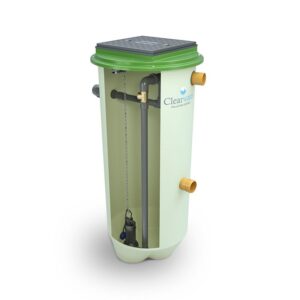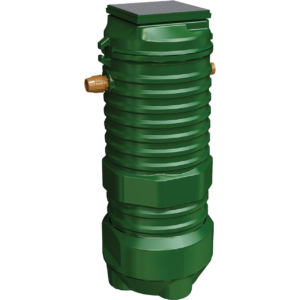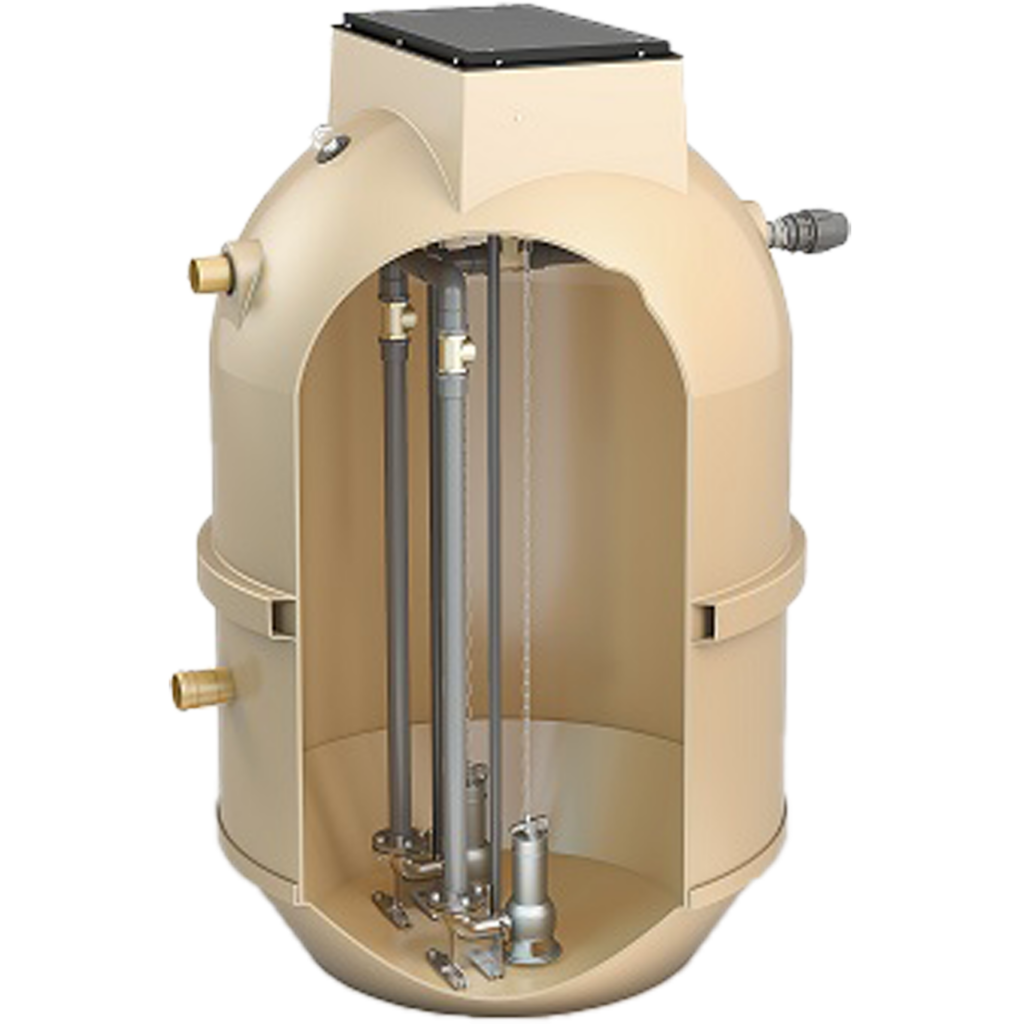Picture this:
You’re building the holiday cottage of your dreams in a stunningly beautiful part of the countryside.
But there’s a snag – there’s no direct access to the main sewer.
How do you deal with that situation?
To paraphrase Jane Austen ever so slightly:
‘It is a truth universally acknowledged, that a person in possession of a good house without access to the main sewer, must be in want of a pumping station’.
But what are pumping stations?
At Drainage Superstore, we’ve put together a comprehensive guide to help you choose the right sewage pumping station for your needs.
Here’s what we have in store for you.
Table of contents:
- What is a pumping station?
- How does a pumping station work?
- What are the types of pumping station?
- What are the factors to be considered while selecting a pumping station?
- How do you size a pumping station?
- Choosing the right pumping station
What is a pumping station?

A pumping station is an underground unit which transports fluids such as wastewater and sewage from one location to another.
To this effect, it consists of a large tank or chamber housing various types of equipment, including:
✅ Pumps
✅ Pump controls
✅ Isolation and non-return valves
✅ Pipework
✅ Guide rail system (optional, to enable quick servicing and repairs)
Pumping stations are used in a wide variety of both residential and industrial settings where there’s no direct connection to the main sewer or the main sewer is located on higher ground than the building itself.
What’s more:
Pumping stations are also used to drain low-lying fields, supply water to canals and much more, making them a tried-and-tested solution to diverse infrastructure system problems.
Traditionally, pumping stations were assembled from components sourced separately, making the installation process rather laborious and complicated.
The good news is:
The emergence of the so-called ‘packaged pumping stations’, which are pre-assembled units with fitted internal pipework ready to be installed, has made the entire process much more straightforward and a lot cheaper.
How does a pumping station work?
All pumping stations function on the same general principle we outlined above.
However, for the purposes of our discussion in this section, we’re going to focus on the domestic sewage pumping station, as homeowners will find this of greater interest.
The process itself is fairly straightforward.
Here’s the deal:
Sewage and wastewater from a property enter the underground tank, also known as a wet well, until a set level is reached.
At this point, a float switch activates the pump (or pumps, depending on the type and model) located at the bottom of the tank. The pump then proceeds to pump out the fluids through the piping all the way to the main sewer, switching off once the amount left in the tank has dropped below the predetermined level.
Finally, a non-return valve prevents the pumped-out fluid from flowing back into the tank.
Now:
Because the whole process involves powerful pumps and the movement of large quantities of fluids and solids uphill, people often wonder:
Is it noisy living next to a pumping station?
This may come as a bit of a surprise, but that’s really not the case.
Firstly, pumping stations are installed well underground under strict regulations.
Secondly, Building Regulations stipulate that a pumping station must be installed at least several metres away from your house (more on that later).
So, the loudest noise you’re likely to hear when your domestic sewage pumping station kicks into gear is something resembling your home refrigerator.
What are the types of pumping station?

There are two ways to distinguish between different types of pumping stations – the first based on Water UK regulations and the second based on design features.
We’re going to take a closer look at both.
Pumping station types based on Water UK regulations
This classification is based on the incoming flow rate and the number of buildings being serviced. The regulations are fully outlined in Sewers for Adoption: A Design and Construction Guide for Developers (8th edition, August 2018).
According to the document, the four types of pumping stations are as follows:
- Type 1 pumping station – incoming flow rate of less than 0.25 litres per second & fewer than 5 dwellings
- Type 2 pumping station – incoming flow rate between 0.25 l/s and 1 l/s & 6-20 dwellings
- Type 3 pumping station – incoming flow rate above 1 l/s with pumps rated at under 30KW & more than 20 dwellings
- Type 4 pumping station – with pumps rated at over 30KW & larger commercial and residential properties. This type falls outside the purview of Sewers for Adoption (SfA), meaning you’ll have to consult your local authority.
Pumping station types based on design features
When it comes to design, the main distinguishing features are the number of pumps and the type of effluent the pumping station is meant to handle.
The main types here are:
- Single effluent pumping station – with one pump, for liquid effluent
- Twin effluent pumping station – with two pumps & control panel, for liquid effluent
- Single sewage pumping station – with one vortex pump, for liquid and solid effluent
- Twin sewage pumping station – with two vortex pumps & control panel, for liquid and solid effluent
- Single grinder pumping station – with one pump, for liquid and hard solid waste
- Twin grinder pumping station – with two pumps & control panel, for large amounts of liquid and solid waste
What are the factors to be considered while selecting a pumping station?

When choosing an appropriate sewage pumping station, there are several matters you need to take into account.
After all, you don’t want to fork out a significant amount of money and dig a massive hole in your garden just to realise you’ve bought the wrong product or fallen foul of some regulations, right?
Having said that, here are the main factors to keep in mind:
Application
First and foremost, there’s the intended application of the pumping station.
Ask yourself:
What kind of sewage will it need to transport? Only liquid? Both liquid and solid?
How about viscosity? Some pumping stations can convey smaller 50mm solids, for instance, while others can comfortably transport large solids in excess of 80mm.
Once you’ve answered these questions satisfactorily, you should know what type of pump station based on design features (single effluent, twin sewage, etc.) you’ll need.
Moving on to the next factor:
Location
Last but certainly not least, there’s the small matter of location. This may seem trivial, but some pumping stations are quite large, and you can’t simply plonk yours anywhere you like and forget all about it.
This means that, depending on the size and makeup of your garden and where you live in the UK, ‘the geography may be a little difficult to arrange’, as Humphrey Bogard’s character Rick Blaine put it in the 1942 film Casablanca.
Classic movie quotations aside, here are the requirements for the minimum sewage pumping station distance from a house and other distances you need to respect across the UK:
In England and Wales, your pumping station (or any other sewage treatment plant apart from a sump and pump, for that matter) should be at least:
- 7 metres away from your house
- 4 metres away from any wall or building
- 5 metres away from any tree, fence or hedge
- 10 metres away from a watercourse or stream
- 50 metres away from a lake or foreshore
In Scotland, your pumping station has to be at least:
- 5 metres away from your house
- 4 metres away from any wall or a building
- 5 metres away from any tree, fence or hedge
In Northern Ireland, your pumping station needs to be at least:
- 7 metres away from your house
- 4 metres from any wall or building
- 5 metres away from any tree, hedge or fence
Bear in mind that it is your sole responsibility to ensure those distances are respected. If that’s not the case, you can expect a hefty fine and potential sanctions from the Environment Agency.
Size
The size of the sewage pump chamber will ultimately depend on the size of your home (or multiple dwellings if that happens to be the case).
At this point, you’re probably wondering:
What size pump station do I need?
That’s exactly what we’re going to look at next.
How do you size a pumping station?
As a general rule of thumb, the minimum daily discharge in domestic settings is 150 litres per person.
But that’s just you’re starting point – there are relevant Building Regulations you have to comply with.
The thing is:
Section H1 2.39 of Approved Document H – Drainage and Waste Disposal (2015 edition) stipulates that the pump chamber should be sufficiently large ‘to contain 24-hour inflow to allow for disruption in service’.
So, you can get a general idea of the size of the tank you’ll require based on the number of bedrooms and occupants in your home. Keep in mind that the first bedroom is classed for two people.
Here are approximate figures for some common domestic properties.
| Number of bedrooms | Number of occupants | Tank volume |
|---|---|---|
| 1 | 2 | 300 litres |
| 2 | 3 | 450 litres |
| 3 | 4 | 600 litres |
| 4 | 5 | 750 litres |
| 5 | 6 | 900 litres |
Now that we have a general idea of how big of a sewage chamber you’re likely to need, let’s take a closer look at pump sizes depending on the height and distance involved.
Most sewage pumps typically have a 2″ outlet and work with a 63mm water pipe. In addition, they are rated based on the ‘head’ or dynamic lift, measured in metres. For instance, a 6m pump will not be able to lift water more than 6m, a 10m pump more than 10m and so on.
With those parameters, the golden rule is:
10 metres of horizontal pumping is equal to 0.5 metres of vertical pumping.
How does that work in practice?
Let’s say your home has to pump water 40 metres horizontally and 3 metres vertically.
Using our handy formula, we see those 40 metres of horizontal pumping amounts to 2 metres of vertical pumping (40 is 4 lots of 10, so 4 x 0.5 = 2). We then add this figure to the vertical pumping and get a total of 5 metres (2 + 3 = 5). So, a 5m head pump should be able to get the job done.
You’re probably wondering:
Shouldn’t I get a more powerful pump, just to be on the safe side?
While this sounds like a good idea, getting a substantially more powerful pump – say a 15m one to do 6m of lifting – will put massive back pressure on the pump and significantly shorten its service life.
Now:
The last thing you should decide in terms of pump sizing is whether you need a single or a twin sewage pump.
The good news is:
There are no calculations involved here!
While a twin pump is more expensive than a single one, it’s preferable for larger houses. That’s because if one of the pumps happens to fail, the second one will take over automatically.
If you have a single pump, on the other hand, you’ll have to scramble to have it repaired or replaced straight away before it can resume pumping water.
Key takeaway:
Use a twin pump for the whole house and a single pump for home extensions or outbuildings with a toilet.
Once you’ve crunched the numbers, you should be able to figure out which of the SfA types 1-4 would be best.
Choosing the right pumping station

Depending on your specific circumstances, a sewage pumping station can be an absolute necessity or a welcome convenience.
Either way:
A pumping station manufactured to strict British Standards for structural strength and watertightness as well as hydrostatic and electrical requirements will be a major asset to your home and help increase its value.
The bottom line is:
With our handy buyer’s guide by your side, you’re well prepared to choose the perfect pump station for your home and have it installed in just the right location.










